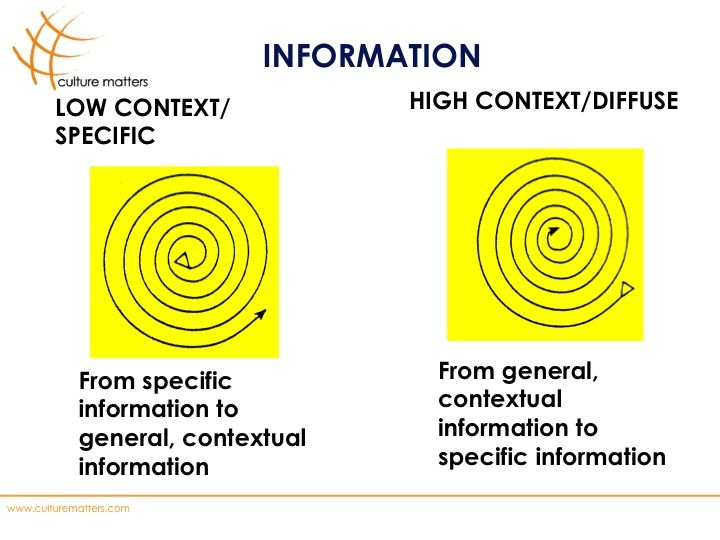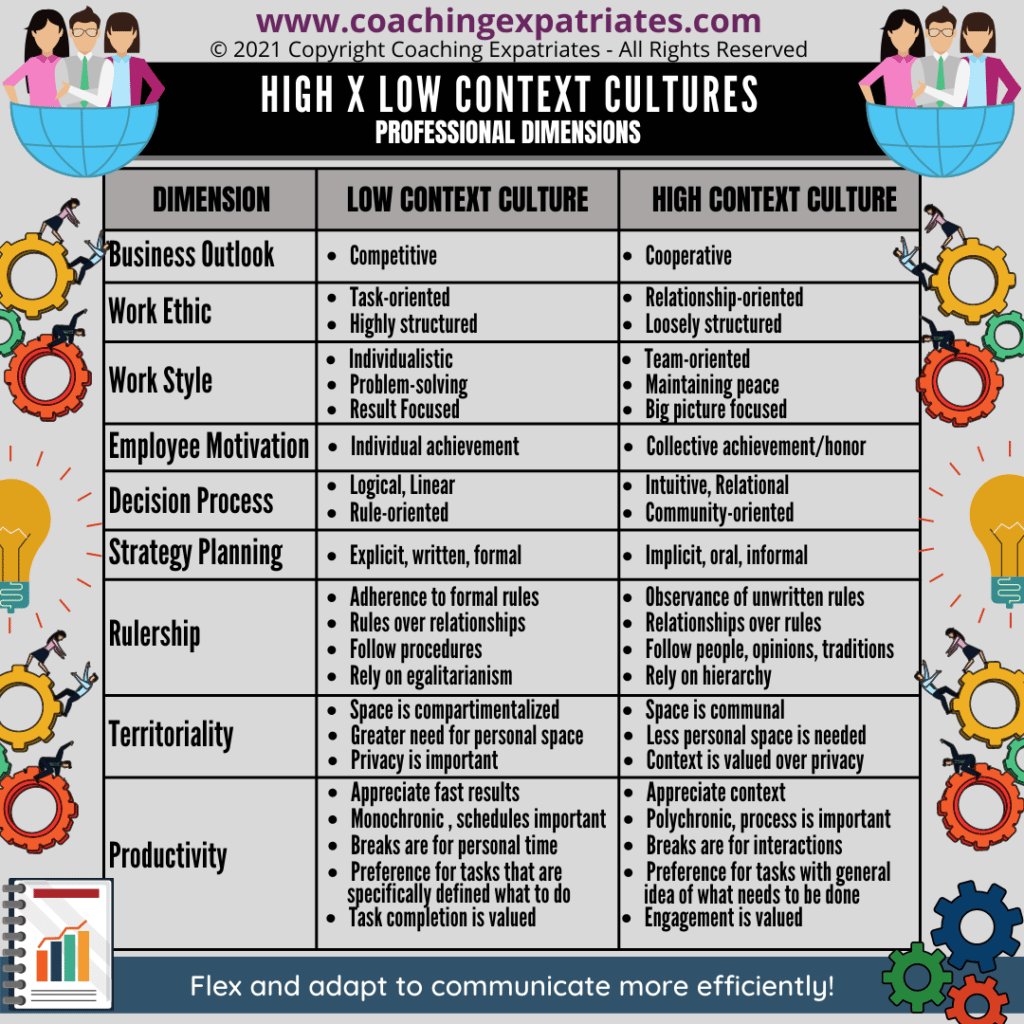Imagine stepping into a business meeting in a foreign country. You’re brimming with enthusiasm, ready to present your brilliant ideas. But instead of engaging conversation and a flurry of agreement, you’re met with polite nods, ambiguous smiles, and a distinct lack of feedback. The silence is deafening. Are they simply being passive-aggressive? Do they disagree with your ideas? Or is there a hidden cultural code at play?

Image: culturematters.com
This, my friends, is the crux of understanding low vs. high context cultures. This framework, developed by anthropologist Edward T. Hall, sheds light on how communication styles, social norms, and even nonverbal cues vary greatly depending on a society’s cultural background. Navigating these differences is crucial for fostering effective communication, building strong relationships, and achieving success in a globalized world.
The Spectrum of Communication: Understanding Context
At its core, the low vs. high context model revolves around the degree of information that is explicitly communicated vs. implicitly understood within a culture. Think of it like a game of telephone. In a high context culture, the “telephone” is passed through a small group of people who share a deep understanding of each other’s backgrounds, beliefs, and values. Messages are often nuanced, encoded with layers of unspoken meaning, and rely heavily on shared history and context.
In contrast, low context cultures are like a “telephone” passed around a diverse crowd. The message needs to be clear, concise, and explicitly stated. Reliance on shared knowledge is minimal, and directness is highly valued. This approach ensures that everyone receives the same information, regardless of their cultural background or prior knowledge.
Low-Context Cultures: Clarity and Explicit Communication
Key Characteristics:
- Emphasis on verbal communication: Spoken words carry the primary weight, leaving little room for ambiguity.
- Direct and explicit communication: Clear, straightforward messages are preferred, avoiding indirect language or hidden meanings.
- Focus on individualistic values: Personal achievements, independence, and self-reliance are highly valued.
- Time is linear and structured: Schedules are strictly adhered to, and deadlines are taken seriously.
- Rules and regulations are emphasized: Formal agreements and contracts are essential for building trust and ensuring fairness.

Image: www.coachingexpatriates.com
Examples:
- United States
- Germany
- Canada
- Netherlands
- Scandinavia
Real-world Scenarios:
- In a low context business meeting, clear agendas, presentations, and detailed reports are expected.
- People directly express their opinions, even if they disagree with colleagues.
- Contracts are meticulously negotiated and reviewed to ensure mutual understanding.
High-Context Cultures: Implicit Understanding and Shared Meaning
Key Characteristics:
- Nonverbal communication is crucial: Body language, facial expressions, and subtle cues carry significant meaning.
- Indirect communication is preferred: Implied meaning and subtle hints are often used to avoid confrontation or discomfort.
- Focus on collectivist values: Harmony, group cohesiveness, and deference to authority are highly valued.
- Time is fluid and relational: Schedules and deadlines may be flexible, and relationships take precedence over strict adherence to timeframes.
- Trust is built through long-term relationships: Personal connections and shared history are important factors in building trust and business partnerships.
Examples:
- Japan
- China
- Korea
- Saudi Arabia
- Mexico
Real-world Scenarios:
- In a high context business negotiation, building rapport and trust is paramount. Time is spent developing personal relationships before diving into the details of a deal.
- Silence can be a powerful form of communication, reflecting thoughtful consideration or disagreement without overt expression.
- Social harmony is highly valued, and conflicts are often resolved through indirect means to avoid public embarrassment or loss of face.
Navigating the Cultural Gap: Tips for Effective Communication
Understanding the nuances of low vs. high context cultures is crucial for:
- Negotiation and Business Partnerships: Effective communication is fundamental to successful collaborations across cultural boundaries. Knowing whether to be direct or indirect, and understanding the importance of personal relationships, can significantly impact the outcome of negotiations and the longevity of partnerships.
- Intercultural Relationships: From personal relationships to cross-cultural teams, awareness of cultural context can enhance communication, avoid misunderstandings, and foster stronger connections.
- Global Travel and Tourism: Understanding cultural norms, etiquette, and nonverbal cues can enhance the travel experience and promote respectful interactions with local communities, making your journey more enriching and enjoyable.
Here are some practical tips to navigate the cultural divide:
- Be mindful of communication styles: In low context cultures, be direct and explicit, providing clear and detailed information. In high context cultures, focus on building relationships, observe nonverbal cues, and be sensitive to implied meanings.
- Practice active listening: Pay close attention to both verbal and nonverbal cues. Ask clarifying questions to ensure understanding and avoid misunderstandings.
- Show respect for cultural differences: Be patient, tolerant, and open to learning about different perspectives. Don’t judge or criticize cultural practices that differ from your own.
- Seek cultural training or mentorship: Consider taking courses or seeking guidance from experts on navigating cultural differences.
- Don’t be afraid to ask questions: If you’re unsure about a particular cultural practice or social norm, don’t hesitate to ask politely for clarification.
Low Vs High Context Culture
Embracing Cultural Differences: A Foundation for Growth
The world is becoming increasingly interconnected, and understanding cultural differences is no longer an option but a necessity. By embracing the low vs. high context framework, we can develop greater awareness, empathy, and sensitivity to the diverse communication styles and cultural norms that exist around the globe. This knowledge empowers us to build stronger relationships, foster deeper understanding, and facilitate positive interactions across boundaries. The journey of intercultural communication is ongoing, and by being mindful of cultural context, we can navigate this journey with greater confidence and success.
This exploration has only scratched the surface of the fascinating world of low vs. high context cultures. I encourage you to continue your journey of discovery. Share your thoughts, experiences, and insights to foster a more inclusive and understanding world!






